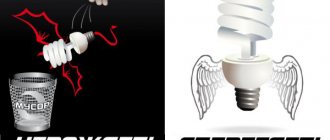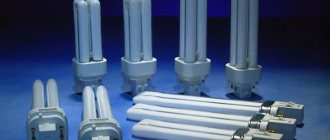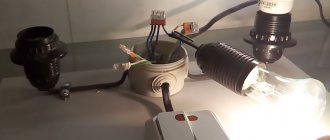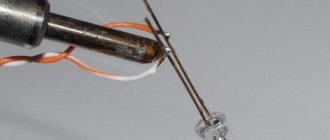Lamps make a slight noise, hum or crackling during operation. Typically, these sounds are a design feature of lighting devices. For example, almost all familiar fluorescent lamps make sounds to one degree or another.
However, when an LED lamp hums, the design of which does not have large transformers or chokes, many people have a logical question - why this happens and what is the source of the sound. Let's take a closer look at this issue.
For what reasons can lamps in a chandelier burn out?
We will give the most likely and common causes of this problem.
Let's consider the proposed options for eliminating it and the possibility of extending the service life of lighting devices. 1) The first reason why light bulbs in a chandelier quickly burn out is probably bad contacts of the wiring and the lamp.
As a rule, all home lighting equipment is connected in two ways: by conventional twisting of wires or by terminal blocks.
When using twisted wires, natural oxidation of the metal occurs. As a result, over time, the resistance at the junction of the wires increases. And this, in turn, leads to voltage drops and lamp burnout. In addition, “eddy currents” arise in the twisting, which lead to interference in the power supply and the same consequences. The only possible solution in this situation is to replace the twisted wires with the terminal.
But when using a terminal block connection, you also need to know one nuance. You should not use stranded wires, since when they are secured in the terminal, the strands spread out and the contact may not be complete. Try to replace the stranded wire with a solid wire. If this is labor-intensive or impossible, then the multi-core contact can be tinned with solder and clamped into the tips.
These tips apply to absolutely all electrical contacts. Try to check the junction box, panel, switches for the quality and reliability of the connections.
2) Faulty lamp sockets or poor contacts in them are the second most “popular” reason why light bulbs in a chandelier can often burn out.
When checking lamp sockets, pay attention to the following:
— reliability and elasticity of contacts between the socket and the lamp inside,
— presence of signs of oxidative processes in the metal contacts,
- darkening or soot.
Any of these reasons leads to overheating of the lamps and their failure.
If in the first two cases it is quite easy to eliminate the cause (bend or clean the contacts), then if there is carbon deposits or darkening, it is necessary to change the cartridge itself.
Our advice: if you often have to clean contacts from oxidation or restore their elasticity, then you should completely replace the cartridge with a better one.
3) Errors in choosing the power of lamps - this is the third reason why light bulbs in a chandelier or other lamp constantly burn out.
Each lighting device is designed to operate lamps of a certain maximum power. And if you use more powerful lamps in it, this leads to undesirable consequences: contacts deteriorate and weaken, internal wiring burns out, and the material of the chandelier elements cracks (including sockets). The end result is obvious - new lamps often burn out.
To prevent such a situation, it is necessary to use lamps of the maximum power for which the cartridges are intended. Otherwise, the material of the cartridges may crack and burn out. Manufacturers indicate the permissible power in the instructions, passport and on the lamp itself in the form of a sticker.
4) Malfunction of switches or junction box can be another reason for the failure of lamps of any type.
Our advice: if on any individual lamp the lamp periodically changes brightness or winks, and you have already checked the chandelier itself and found no faults, then you need to look for the cause in the switch or junction box. Carefully inspect their insides for darkening and carbon deposits, check all contacts. If found, correct the problem immediately.
5) Increased power supply voltage or power surges also affect the operating time of any equipment in the apartment, including lighting. Halogen, energy-saving, LED lamps often burn out due to a sudden voltage surge.
You can insure against such problems by installing a voltage stabilizer at the entrance of the electrical network to the apartment.
6) Frequently turning on/off lighting fixtures can also be the reason why halogen or energy-saving light bulbs quickly burn out.
Our advice: you can protect yourself from this by installing specialized equipment that allows for smooth switching on/off of lighting devices.
We have given the most common causes of burnout of various types of lamps and possible ways to eliminate them.
But it should be noted that the quality of the light bulbs and the lamp themselves also directly affects the service life. Try to purchase lighting equipment from trusted manufacturers, of proper quality and from reliable sellers.
Main reasons
There can be many reasons why an LED lighting fixture sometimes makes noise. This includes resonance from supporting structures, sounds from additional devices, and other reasons. The appearance of a hum greatly interferes with work or rest, distracts and irritates a person.
If the hum moves into the ultra-low frequency region, serious health problems, mental disorders, anxiety and panic conditions are possible. Therefore, the causes of unwanted sounds must be identified and eliminated. Let's look at some possible and common situations .
Dimmer noise
A dimmer is a device that allows you to smoothly change the brightness of a lamp. A very convenient device, but it is often the source of noise. There are two dimmer designs, designed for traditional incandescent lamps and for LED fixtures.
If, unknowingly, a dimmer for an incandescent lamp is connected to an LED lamp, the device begins to hum, the intensity of the sound will depend on the power and the degree of inconsistency between the LED and the regulator. The way out of the situation is to replace it with a suitable dimmer.
Poor quality assembly
Poor manufacturing quality of the LED lamp is also a common cause of noise. The lamp begins to hum due to a leak in the seal (sometimes this does not happen immediately, but over time).
Interesting! In addition, a low-quality transformer may be used in the design of an LED lamp (this is typical for lamps with built-in PWM). Then the device also noticeably hums or begins to whistle. The solution to the problem is to replace the lamp with a more reliable one from a well-known manufacturer.
Other
Without exception, all dimmers hum during operation. However, with high-quality assembly of the device, the operating noise level is low and is not noticeable by humans. When installed in plasterboard boxes or other structures capable of resonating in the broadband range, the lamps begin to hum much louder. Possible causes of resonance:
- tight contact of the lamp with the walls of the box;
- the block with the power wire comes into contact with the ceiling slab, transmitting vibration to it;
- the devices are installed too close to the metal guides that form the frame of the box;
- the walls of the box are not tightly assembled and begin to rattle or hum when the lights are turned on.
All such issues can be resolved in one way - by reinstalling the lamp or changing its position, excluding contact with the load-bearing elements or casing. Sometimes the box is already ready and finished, which makes it difficult to reconstruct.
In such cases, it is recommended to look for a lamp of a different shape or size. There is a large selection of types and designs on sale, allowing you to replace a problematic LED lamp with a more successful one.
How to properly connect a light bulb to the wires?
Before connecting the light bulb to the wires, you should take care of safety precautions and turn off the power supply. In order to carry out this action correctly, you must adhere to some specific rules. First of all, if there is no recess in the walls for a switch, then one must be made.
Next, you will have to stretch the electrical wires to the desired location; you need to pull them from the junction box. As a rule, these two wirings are well known to everyone - zero and phase. The above wires will have to be laid open or closed. In the first of the listed options, the gasket is made in special plastic boxes placed on top of the wall.
LED lamps and dimmers: problems and nuances of choice [video]
Today, choosing LED lamps so that they are both high-quality and inexpensive is a rather troublesome task, if not difficult, but it becomes much more confusing when you need to correctly select dimmers for LEDs.
Domestic consumers, for the most part, have already learned to more or less correctly select LED lamp models based on parameters such as color temperature, luminous flux and scattering angle.
However, as practice shows, the user begins to check the compatibility with dimmers of a purchased LED lamp after its purchase, and not before.
And only then, faced with the fact that a regular dimmer for incandescent light bulbs does not want to work properly with LED lamps, does the disappointed user begin to look for the cause of the problem and/or immediately returns the purchase to the store. As they say, what to do?
Let's start with the problems . As you know, “old” incandescent lamps with dimmers always work well, since their brightness directly depends on the strength of the supplied current. Simply put, you need to add/decrease the brightness of the lamp by turning the dimmer knob, respectively, adding/decreasing the current. Nothing complicated.
With LEDs, things are not so simple. If you start using an LED lamp with a regular dimmer, you will soon find out the following:
- the lamp either does not turn on at all,
- or it turns on, but is constantly lit at 100% brightness,
- or, having turned on, immediately begins to emit a loud hum, crackling or...
- flickers unpleasantly at a certain or at all positions of the dimmer knob.
However, sometimes it happens that an LED lamp with a regular dimmer works fine at first, but then turns off at various brightness levels. This mainly happens when the LEDs are supplied with less than the minimum voltage needed to power them.
But the essence of the fable in this case is always the same: when using an LED lamp with a conventional dimmer for incandescent lamps, both the LED lamp and the dimmer may fail.
Therefore, dimmers of a special design are produced for LEDs, in which the brightness of the lamps is changed not by reducing or increasing the strength of the current flowing through them (as in incandescent light bulbs), but by changing the width of the direct current pulses that are supplied to the LEDs. By the way, in this case there is no need to worry about the flickering of the lamp being noticeable, since the frequency of such pulses in an LED lamp can reach 300 kHz, and the human eye perceives them as an even glow.
Another important nuance: not all LED lamps can work even with special dimmers. Why? The answer is obvious. Pay attention to the prices and you will see that a regular LED lamp costs significantly less than one with similar characteristics, but dimmable, that is, more complex and, of course, more expensive to manufacture.
In other words, manufacturers initially produce lamps of different types, focusing both on the needs of their potential consumers and on competitive offers.
How to choose the right dimmable LED lamp?
- First of all, you should pay attention to the markings printed on the packaging of the LED lamp; models with a brightness adjustment option (dimmable) are usually marked, and if you do not find the corresponding icon and/or inscription, then most likely the lamp is not for a dimmer (see above and below):
- With regular dimmers for incandescent lamps, new LED lamps most likely will not work, therefore, when buying such lamps, buy special dimmers for them (more details about the parameters of dimmers for LED and LED lamps can be found here - https://salonlustr .com.ua/c9_41-Svetodiodnaya_lampa-LED);
- if, after connecting an LED lamp to a regular dimmer, you notice (see or hear) that it is not working correctly, then it is better to stop the “experiment”, since the lamp may fail;
- so-called LED smart lamps (“smart light bulbs”) are not designed to work with any type of dimmer at all, as they are equipped with built-in brightness adjustment devices, which often conflict with external dimmers, causing problems with the lamp.
Second installation method
- If there is no access to the distribution box, you can solder a resistor directly in front of the socket at the point where the lamp or chandelier is connected to the network.
- The maximum permissible voltage must be at least twice the value in the network, that is, 440 V. 630 V capacitors are suitable for these purposes.
- If this could not be found, a 400 V capacitance will also do, but it should be connected according to a circuit with one series and additional shunt resistance in accordance with the following circuit.
Please note that you can increase the safety of using a shunt resistor by insulating it using heat shrink or a simple cambric of suitable diameter.
Using an additional capacitor
At its core, a capacitor is a reactance. Therefore, its use will provide a result similar to installing a shunt resistor. The only difference is that the capacitor does not consume active energy, so there will be no reaction from the electric meter to such a decision.
Install the capacitance according to the same principle as resistors - in the junction box or in front of the cartridge. But when choosing an element, you should pay attention to its parameters:
Connection diagram for a capacitor with resistances
Please note that a capacitance of 0.33 μF is sufficient, but do not use electrolytic capacitors, but ceramic or paper elements. Electrolytes can leak or even explode if incorrectly selected and in emergency operating modes.
Connecting a separate neutral wire
If both neutral and phase wires are connected to the switch, then the problem can be solved even easier. You will need to connect the backlight to both of these wires. With such a rigid connection scheme, the indicator will light constantly, but the main LED lamp will stop blinking.
Diagram with connection of a separate neutral wire
Combination of LED and simple incandescent lamps
When it comes to blinking lamps in a chandelier, the problem can be eliminated even easier. To do this, screw a regular incandescent light bulb into one socket. In this case, it will act as a shunt and the flickering of the LED light source will stop.
It should be understood that in this case, energy savings will be less, which is associated with the cost of a regular lamp.
What causes light bulbs to explode?
The very reason for the explosion of the light bulb lies in the fact that over time, as a result of depressurization, the discharged environment inside the lamp is sharply filled with pressure, the bulb is destroyed, which is often accompanied by flying fragments in different directions of the room.
This may be the case when modern houses are supplied with a sufficiently high voltage that an ordinary light bulb cannot withstand. If this is the problem, then you will have to look for specialized lamps designed for use specifically at high voltage.
Another reason may be low quality products. For an example, see the picture below. This is a completely new light bulb that I bought and could not install in the chandelier, when I started to inspect it, it turned out to have a crooked base and a hole in the thread.
Unfortunately, at present, domestic manufacturers lag behind their foreign colleagues in terms of lamp quality, and the price of the issue is insignificant. For each of the lamps there is a passport, which indicates the power of the light bulbs for this model. These instructions must be followed, otherwise the bulbs will flicker, not provide enough light, or explode and burn out.
We also note that the switches must also be in good working order. If the contact moves away from them, this again affects the performance of the light bulb. In order to avoid such moments when light bulbs explode, it is worth switching to using halogen lamps. They integrate a special protection unit that takes care of voltage surges in the network. It is best to replace old switches with rheostat ones, which can reduce the voltage to the light bulb itself when it is turned on.
Not ideal color rendition
The color rendering index of our LED lamps exceeds 80, which is verbally rated as “very good”. Although only incandescent lamps and natural daylight have a higher index, it must be said that this is not ideal color rendition.
It would be more accurate to note that this is a different color rendering. Therefore, replacing high-power incandescent and/or halogen lamps with LEDs in some cases may cause visual discomfort.
For example, an interior with a predominance of deep blue shades (under halogen lamps) will change its appearance after installing cool LED lamps - the blue color will “move” into a bright purple area. And for people sensitive to color, such shade transformations are a significant drawback.
This is also one of the reasons why you can’t directly compare incandescent and LED lamps – a lot depends on the interior.
External influence factor
Unfortunately, despite the use of modern technologies and devices for protecting electrical appliances, today it is impossible to guarantee with 100% certainty the proper operation of LED lamps when exposed to external forces. Both fluorescent lamps and LED lamps are characterized by a reaction to static voltage that occurs during thunderstorm activity. And if a lightning charge enters a house unprotected by a lightning rod, in 100% of cases the diode light bulbs will burn out.
Video: How to choose LED lamps. Using a mobile phone!
Video: Connecting LED and Energy Saving Lamps to a Backlit Switch
Video: LED lamps glow when turned off. What to do!
Why is an energy-saving light bulb harmful?
Due to the fact that the gaseous environment of a fluorescent lamp contains a certain amount of mercury vapor, as a result of which there is a danger of poisoning. Long-term human contact with mercury vapor and its chemical compounds ends in death, but it should also be understood that even short-term contact can cause poisoning and even a neurological disease - mercurialism .
Ultraviolet radiation comes out through the glass bulb of a fluorescent lamp, which can be dangerous for people with sensitive skin. Its danger lies in its effect on the eyes, damaging the retina and cornea.
The harm from energy-saving light bulbs lies in the danger of poisoning with mercury vapor and exposure to ultraviolet radiation on the cornea and retina.
How to choose a chandelier fan?
When dealing with a hybrid device, you need to pay attention to several parameters when purchasing
For a ceiling paddle light, luminous power and cooling characteristics are important. Here is a list of the main criteria:
Here is a list of the main criteria:
- The power of the lamp used must correspond to the area of the room.
- A ceiling fan chandelier with a remote control makes it easy to switch lighting modes and adjust the rotation speed of the blades.
- The diameter of the blades and engine power are selected taking into account the living space. Size 762 mm is suitable for rooms up to 9 m², 1066 mm - for a spacious room up to 16 m², 1320 mm - for a studio apartment up to 32 m².
- Be sure to take into account the design of the lamp and the style of decoration of the premises.
- The minimum room height for installing a chandelier-fan is 2.1 m.
How to remove the flickering of a budget LED lamp with your own hands: 3 schemes
Above in the text, I tried to focus your attention on the fact that you should not purchase cheap LED lamps. But, if they have already been purchased, then you can try to improve their performance
Method No. 1. Increasing the capacity of the equalizing capacitor
A simple power supply for an LED lamp after a voltage divider or input transformer rectifies the alternating signal with an electrolytic capacitor C, which smoothes out ripples.
Their influence on the quality of the equalized signal can be reduced by increasing its capacitance. To do this, it is permissible to connect an additional capacitor C1 in parallel with the windings C.
The second option is to replace capacitor C with another one of higher capacity. The principle here is: the more, the better. But, without fanaticism. The fact is that all this electronic equipment is located in the lamp base, and the dimensions there are limited.
You can, of course, try to bring the additional capacitor out with wires, as a separate module. But how convenient will such a design be during operation?
I showed this solution on the diagram with dotted lines and highlighted the added elements in lilac.
Here I also indicated a place to connect an additional resistor R1.
Method No. 2. Limiting the current through the LEDs with a current suppression resistor
Connecting additional resistance R1 in a series circuit with LEDs reduces power consumption, load current and reduces their glow, and at the same time ripple.
It is quite enough to reduce the current through the HL1-HLn chain by 25-30 percent. You will need to measure the voltage drop across it with a multimeter in a real circuit and then make a calculation.
Knowing the voltage and resistance R=1 kOhm, the current flowing through all LEDs is calculated using Ohm's law. In principle, you can also measure it, or use an online calculator.
Next, we simply reduce the current value by about a quarter and calculate the total resistance. From it we subtract the value of resistor R and get the value of R1.
Do not forget to select it according to the permissible power. Otherwise, it may overheat and disrupt the temperature regime of the entire ice structure or even burn out.
Both methods of using an additional capacitor and resistor do not radically eliminate the blinking of the LED lamp, but significantly limit it. Such modified lamps can be installed in utility rooms, where they will work quite reliably.
The owner of Master Bobrov shows options for the technical implementation of these two methods in his video. You may also benefit from reading the comments below the video.
xEaFInT-74g
Method number 3. Connecting homemade filters
I think this method is more effective than those discussed above. I have already explained the principle of its operation earlier, looking at the circuits of switching power supplies.
The connection of chokes and capacitors should suppress high-frequency interference that comes from the network to the power supply of the LED lamp. For the simplest drivers this is quite enough.
Such a filter can be assembled as a separate module and turned on directly in front of the lamp. It does not have to be built into the light bulb base. It will not create problems with the design of a small-sized structure.
The filter is made in a dielectric housing and is mounted anywhere in the apartment, but preferably in front of the cartridge.
This is, in principle, the whole explanation of why LED lamps blink when they are on. Now I will briefly touch on a similar issue when the voltage is turned off by the switching device.
Dimmers for LED lamps
Dimmers specifically designed for LED lamps are beginning to appear on sale. I bought and tested two models: Legrand Etika 672219 and Schneider Blanca BLNSS04001.
Most LED lamps are not dimmable, but there are also dimmable lamps, the brightness of which, in theory, can be adjusted with a regular incandescent dimmer.
Many have encountered the fact that dimmable lamps work poorly: they either shine too brightly at the minimum level, or at some levels their light begins to tremble, or they hum when dimming, or they generally flash and flicker. It turned out that almost every lamp model works in its own way with each dimmer model. First of all, the reason for this is that conventional dimmers are not designed for LED lamps; many of them indicate a minimum load of 40-60 W and often this is less than the consumption of the entire chandelier with LED lamps.
Last year, I tested how ten different dimmers work with fifteen models of LED lamps (habr.com/ru/company/lamptest/blog/430678). Only one dimmer out of ten worked flawlessly with all lamps, but it was a radio-controlled dimmer specifically designed for LED lamps.
Among the hundreds of conventional rotary-knob dimmers on sale, you can find several models designed for LED lamps. Their packaging indicates that they work with LED lamps, but most sellers and online stores, due to illiteracy, do not indicate this in any way.
Such dimmers can be distinguished by several characteristics:
- a clear indication on the packaging and in the instructions that the dimmer works with LED lamps;
- low minimum power level (usually from 5 W) and low maximum power level (100-400 W);
- availability of adjustment of the minimum dimming level;
- the ability to switch the dimming method based on leading or trailing edges.
Different lamps perform differently when dimming with leading edges and dimming with trailing edges. It happens that when dimming at the leading edge, the lamps hum loudly, but at the rear there is almost no sound. Others, when dimming along the trailing edge, “go crazy” - they flash and blink. Still others, when dimming along the leading edge, glow too brightly even at the very minimum dimming, and when dimming along the trailing edge they can go out almost to zero. This is why the ability to switch the dimming method is important for LED lamps.
All the signs listed above are present in two dimmers that I found and bought for experimentation.
Legrand Etika 672219 costs 1,475 rubles and you need to buy an additional frame for it. Schneider Blanca BLNSS040011 (the last number means the color) costs from 1,425 rubles and has a frame already included.
Legrand Etika 672219 can work with conventional incandescent or halogen lamps with a total power of up to 300 W or dimmable LED lamps from 5 to 75 W (maximum 10 lamps). It is controlled by an endlessly rotating encoder knob (adjustment from minimum to maximum - 1.5-2 turns). Pressing the handle turns the light on and off.
It is possible to connect additional control buttons, with which you can either turn the light on and off (short press) or adjust its brightness (long press).
There is an additional contact for connecting buttons; two L contacts are connected to each other.
The dimming method is changed using a microswitch on the side wall.
The minimum brightness level is adjusted by long pressing the knob.
Why are the lights buzzing?
While in the second case the cable is laid into grooves prepared in advance in the wall.
The zero wire must be laid along the ceiling and walls directly to the lighting device itself. The phase should be directed to the switch, or rather to the input contact, and at the output the phase approaches the light bulb. It is imperative to ensure that this sequence is followed, otherwise the light bulb may be under dangerous voltage even when turned off.
Next, both wires, zero and phase, are attached to the socket, into which the light bulb will then be screwed. It is enough for a simple person to remember that the phase is supplied directly to the base, while the zero is supplied to the thread. After you have managed to install the switch for the light bulb, you need to place it in a box prepared in advance for it and they also need to check the functionality of your entire circuit.
Illuminated switch
The most common reason for a lamp to glow after being turned off is backlit switches.
Inside such a switch there is an LED with a current-limiting resistor. The LED lamp glows dimly when the light is turned off, because even when the main contact is turned off, voltage continues to flow through them.
Why does an LED lamp burn at full heat and not at full power? Thanks to the limiting resistor, the current flowing through the electrical circuit is extremely insignificant and insufficient to light an incandescent electric lamp or ignite fluorescent lamps.
The power consumption of LEDs is tens of times lower than the same parameters of an ordinary incandescent lamp. But even a small current flowing through the backlight diode is sufficient for the LEDs in the lamp to glow weakly.
There can be two lighting options. Either the LED lamp lights up continuously after turning off, which means that sufficient current flows through the LED backlight of the switch, or the light flashes periodically. This usually happens if the current flowing through the circuit is too small to cause a constant glow, but it recharges the smoothing capacitor in the power supply circuit.
When sufficient voltage gradually accumulates on the capacitor, the stabilizer chip is triggered and the lamp flashes for a moment. Such blinking must be definitely combated, no matter where the lamp is located.
In this operating mode, the lifespan of the power board components will be significantly reduced, since even the microcircuit does not have an infinite number of operation cycles.
There are several ways to eliminate the situation when the LED light is on when the switch is off.
The simplest is to remove it from the backlight switch. To do this, we disassemble the housing and unscrew or bite off with wire cutters the wire going to the resistor and LED. You can replace the switch with another one, but without such a useful function.
Another option would be to solder a shunt resistor in parallel with the lamp. According to the parameters, it should be designed for 2-4 W and have a resistance of no more than 50 kOhm. Then the current will flow through it, and not through the power driver of the lamp itself.
You can purchase such a resistor at any radio store. Installing the resistor is not difficult. It is enough to remove the lampshade and fix the resistance legs in the terminal block for connecting the network wires.
If you are not particularly friendly with electricians and are afraid to “interfere” with the wiring yourself, another way to “fight” backlit switches can be to install a regular incandescent lamp in the chandelier. When turned off, its spiral will act as a shunt resistor. But this method is only possible if the chandelier has several sockets.
Expensive
If you decide to replace your incandescent lamps with LED ones, be prepared to pay up to 10 times more - they are approximately that many times more expensive. And this is their first and main disadvantage.
The high price is compensated by 10-fold energy savings. In addition, LED lamps are much less likely to burn out, which means additional savings on the cost of new replacement incandescent lamps. And don’t forget about your time and a slight headache - remember that you need to buy a light bulb to replace the burnt one, remember what kind of base it has, and it would also be nice to have a spare for that room, but what kind of lamps are needed there. And so on.
Depending on the mode of use, the payback period may occur as early as 6 months after replacing the lamps with LED ones.
One note needs to be made here
.
Recently, there have been a lot of offers of LED lamps on the market at bargain prices. But don’t delude yourself about this. We bought several of these products, disassembled and tested them and received very disappointing results
.
There are several reasons for this unpleasant phenomenon.
Dimmer noise from a previous fixture with traditional incandescent bulbs. These also include halogen incandescent lamps. This group of lamps has varieties:
- powered directly from an industrial network 220 V 50 Hz;
- powered by a step-down transformer with an output voltage of 12 or 24 V.
Transformers with a ferromagnetic core sometimes hum in such lamps due to poor manufacturing quality. The EPRU, an electronic ballast, can also make noise.
The cores or loosely wound and not varnished windings hum in them. The buzzing occurs at the network frequency, i.e. 50 Hz. It is caused by a thyristor or triac dimmer to regulate brightness via a 220 V circuit.
Noise can also come from a lamp with LED lamps, the brightness of which is adjusted using the PWM procedure - pulse width modulation. The PWM frequency is usually higher than tens of kHz, i.e., inaudible. But sometimes in lamps from nameless manufacturers it is about 200 - 300 Hz. And low-quality transformers in the PWM part can also slowly squeak at this frequency.
An LED lamp also hums when a powerful LED or an assembly of several low-power LEDs is powered from a 220 V network. In this case, separate switching power supplies are used. If their design is not airtight, that is, it is not placed in a solid housing and not filled with compound, then they can also hum. But they usually whistle at a high frequency. If the power reserve of such a source is 30 - 50%, then they can be placed behind a suspended false ceiling or hidden in a ceiling niche. It is advisable to check the temperature of the power supply case after ten minutes of nominal operation. The heat should not burn your hand, i.e. be insignificant.
Buy wall lamps and other modern light sources guaranteed to not buzz on our website.
leave your chandelier alone. everything is connected correctly there. and striped is also correct
The only thing is, if you have nothing to do, you can take it off. take it to OBI.
explain the situation to them. maybe they will change it for you. maybe the other one won't buzz.
What does OBI have to do with it? In such a situation, the wife needs to be changed, not the chandelier. If it weren't for her, they wouldn't have climbed that ladder.
check the contacts, are the connections secure? no signs of overheating?
LED Trafo (Driver)
if the previous lamps had a bad life, perhaps due to poor contact
place something soft between the Driver and the lamp body or drop a couple of dots of thermal/hot glue
maybe it will be quieter
but the “filling” of the Driver is still noisy
n.p. Thanks for the advice.
Today I talked (or rather, my wife talked, I work during the day) at OBI, they said that there had been such people and offered to return the money. That’s probably what we’ll do: I’ll take it off, unscrew it, pack it, and take it to the Ob.
I don’t quite understand why money and not a new identical chandelier that doesn’t hum, but I’ll discuss this with them on Saturday
25 years ago, low-frequency converters were common, the hardware of which hummed from the 50Hz network if it was poorly connected.
We fought against the buzzing in two ways - by tightening the mounting bolts and by lubricating (coating) the transformer iron with glue.
The second method may work.
The inductor in the PWM is probably “itching”. Return it, and if you like it so much, ask to connect another one in the store, and let your wife listen.
At work I had two tables pushed together, with three (sometimes four) computers on them, everything humming, naturally. But there was one device that was rarely connected (its own switching power supply in the socket), which we did not even immediately understand (with just two of us in the room) that it was it. You can't hear it, but somehow you start to get tired when it's plugged in, and you feel relieved when you unplug it. If you listen, it emits a thin squeak. We changed the power supply and began to live peacefully.
It’s easier for OBI to return your money than to bother choosing a lamp for you (or maybe they’re all the same, how does the seller know? And he’s not interested).
the driver is humming, if you have a 25-watt driver it will hum and is quite audible, and even with a dimmer inside, the fact is that it works at the limit of its power, plus the quality of all these obi and baumarkts is on the verge of a foul, that’s all, high-quality the lamps do not buzz, although they are made in China, but there are more powerful wire drivers and high-quality leads and assembly, but the price is different there, nothing is cheap and cheerful, the market is thin))))
Main conclusions
Humming or whistling noises that occur when LED luminaires operate are a consequence of the use of unsuitable regulators or poor quality assembly. In addition, the backlight often hums due to the resonance of the support structures with which it comes into contact.
All options should be examined by elimination to determine the cause of the extraneous noise. If you know how to find out the reason for the hum of an LED lamp, share it in the comments on this page, it will be valuable and necessary information for all owners of LED devices.
What causes light bulbs to explode?
The very reason for the explosion of the light bulb lies in the fact that over time, as a result of depressurization, the discharged environment inside the lamp is sharply filled with pressure, the bulb is destroyed, which is often accompanied by flying fragments in different directions of the room.
This may be the case when modern houses are supplied with a sufficiently high voltage that an ordinary light bulb cannot withstand. If this is the problem, then you will have to look for specialized lamps designed for use specifically at high voltage.
Another reason could be low quality products. For an example, see the picture below. This is a completely new light bulb that I bought and could not install in the chandelier, when I started to inspect it, it turned out to have a crooked base and a hole in the thread.
Unfortunately, at present, domestic manufacturers lag behind their foreign colleagues in terms of lamp quality, and the price of the issue is insignificant. For each of the lamps there is a passport, which indicates the power of the light bulbs for this model. These instructions must be followed, otherwise the bulbs will flicker, not provide enough light, or explode and burn out.
We also note that the switches must also be in good working order. If the contact moves away from them, this again affects the performance of the light bulb. In order to avoid such moments when light bulbs explode, it is worth switching to using halogen lamps. They integrate a special protection unit that takes care of voltage surges in the network. It is best to replace old switches with rheostat ones, which can reduce the voltage to the light bulb itself when it is turned on.
Myths about LED lamps
LED lamps burn forever
Of course this is not true. Like any electronic device, an LED lamp can break or stop working properly.
So don’t get your hopes up – you will also have to change the LED lamps. Just not so often - many times less often.
A 2 watt lamp will replace 60 watts
This amazing myth was brought by our customer. And the surprising thing about it is that she quoted her electrician. It’s enough just to turn on these two lamps next to each other to make sure that this is far from the case - modern LEDs are efficient, but not to that extent!
Even if the theoretical limit of LED efficiency is ever reached, even then a two-watt bulb will not produce as much light as a 60-watt incandescent bulb. Although I must admit that she will get very close to this.
At the moment, to get something similar to a 60-watt incandescent lamp, you need to take an LED lamp that consumes at least 7 watts
.
More efficient LEDs exist, but are still far from mass production - their price lives in some other world.
Faults and wiring defects
LEDs deteriorate if the network experiences frequent power surges. They can arise due to problems on power lines or directly in the apartment. It is necessary to prevent violation of the integrity of the wire insulation.
LED lamps, like fluorescent energy-saving lamps, do not tolerate low voltage. It is recommended to check the quality of connections in the junction box, the lamp connection wires, and eliminate twists.
It is convenient to use Wago type terminal blocks. In addition to these, there are reusable terminal blocks from which you can remove the wires and reconnect them. Old switches harm the LEDs and the power supply because their contacts wear out over time and begin to spark when turned on/off. Each wire must be well insulated.
This is interesting: Jazzway and Philips lamps comparison - let's look at the essence
How to recycle energy-saving light bulbs?
It must be remembered that fluorescent lamps are not thrown away like ordinary garbage, where they break and all breathe mercury vapor, and recycling of energy-saving light bulbs occurs by handing them over to the appropriate collection points.
Bottom line
There are a lot of problems with energy-saving fluorescent lamps. The most common are flashing, sound effects and may cause unpleasant odors. In order to prevent these phenomena, it is necessary to choose lamps from time-tested manufacturers that meet a large number of international standards (from five), and use energy-saving LED lamps.
Circuit with electromagnetic (throttle) ballast
This circuit consists of an inductive ballast (choke) and a pulse ignition device (starter), possibly having a compensating capacitor.
When voltage is applied, a glow discharge occurs in the starter. When heated, the bimetallic plates from which the starter electrodes are made close, as a result of which the current in the circuit increases significantly. The increased current heats up the electrodes of the fluorescent lamp, and they begin to emit electrons. At the same time, the starter electrodes cool down, the bimetallic plate bends and the circuit breaks. Thus, the starter is needed only at the moment of starting; it does not participate in further operation and its electrodes remain open. In this case, due to self-induction, a short-term high-voltage pulse occurs at the choke, which leads to a gas discharge and ignition of the lamp. When the lamp is lit, the voltage on its electrodes is lower than the mains voltage by the amount of self-induction emf that occurs in the inductor when the lamp is ignited. Thus, the inductor prevents the current from increasing during the operating mode of the lamp.
The disadvantages of this scheme are the long time it takes to turn on the lamp; as the inductor wears out, it begins to emit a hum, and low efficiency at subzero temperatures.
Big size
This is the second drawback. LED lamps are larger in all respects than conventionally similar incandescent lamps. They are wider, longer, heavier.
The reason for this is technological. Incandescent lamps are not afraid of high temperatures; they can heat up to temperatures of structural failure, when glass or glue ceases to be solid. Therefore, their usual heating to 100-300 degrees has practically no effect on functionality (of course, if we do not touch upon fire safety issues).
On the other hand, LEDs should not get very hot
, because When heated, their efficiency decreases significantly and the process of burning out intensifies - they become dull. Therefore, they need to be cooled, which is why LED lamps have a heat sink. And the higher the lamp power, the larger the radiator will be.











